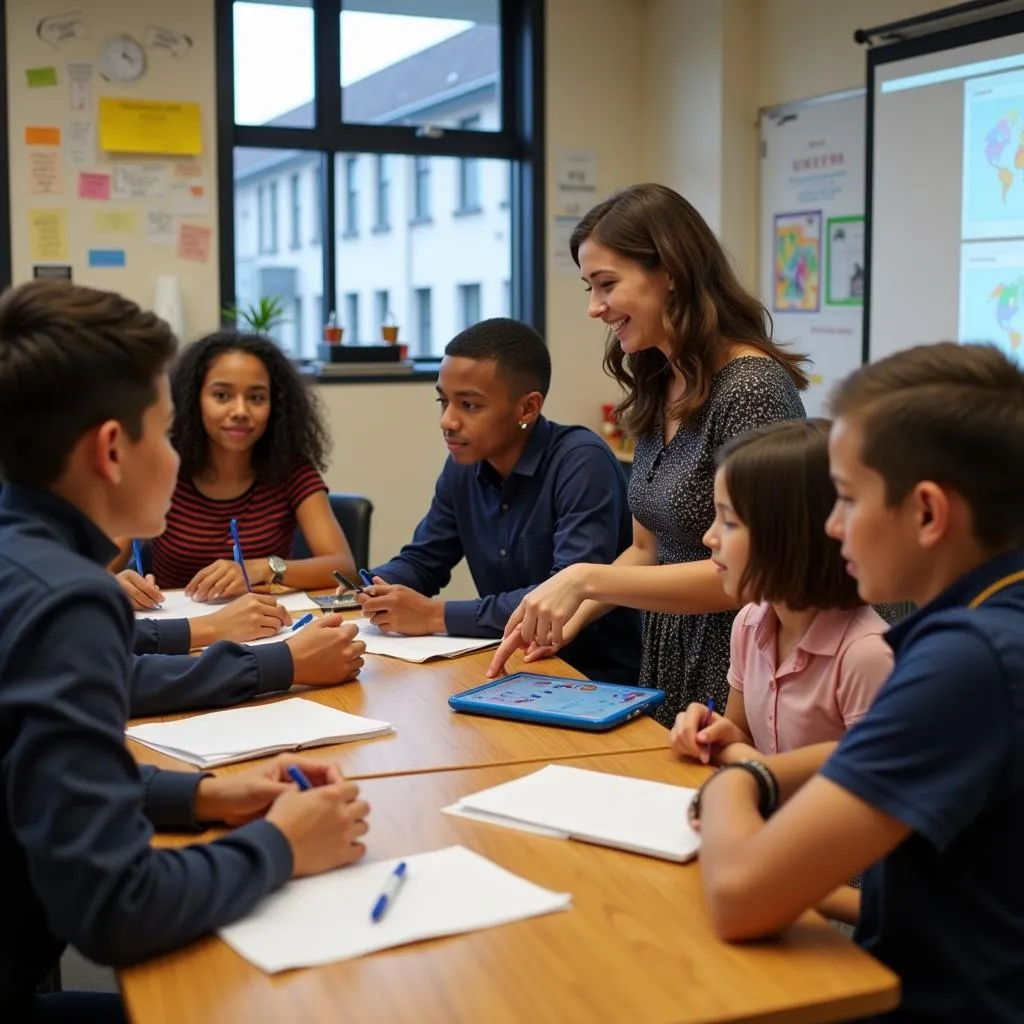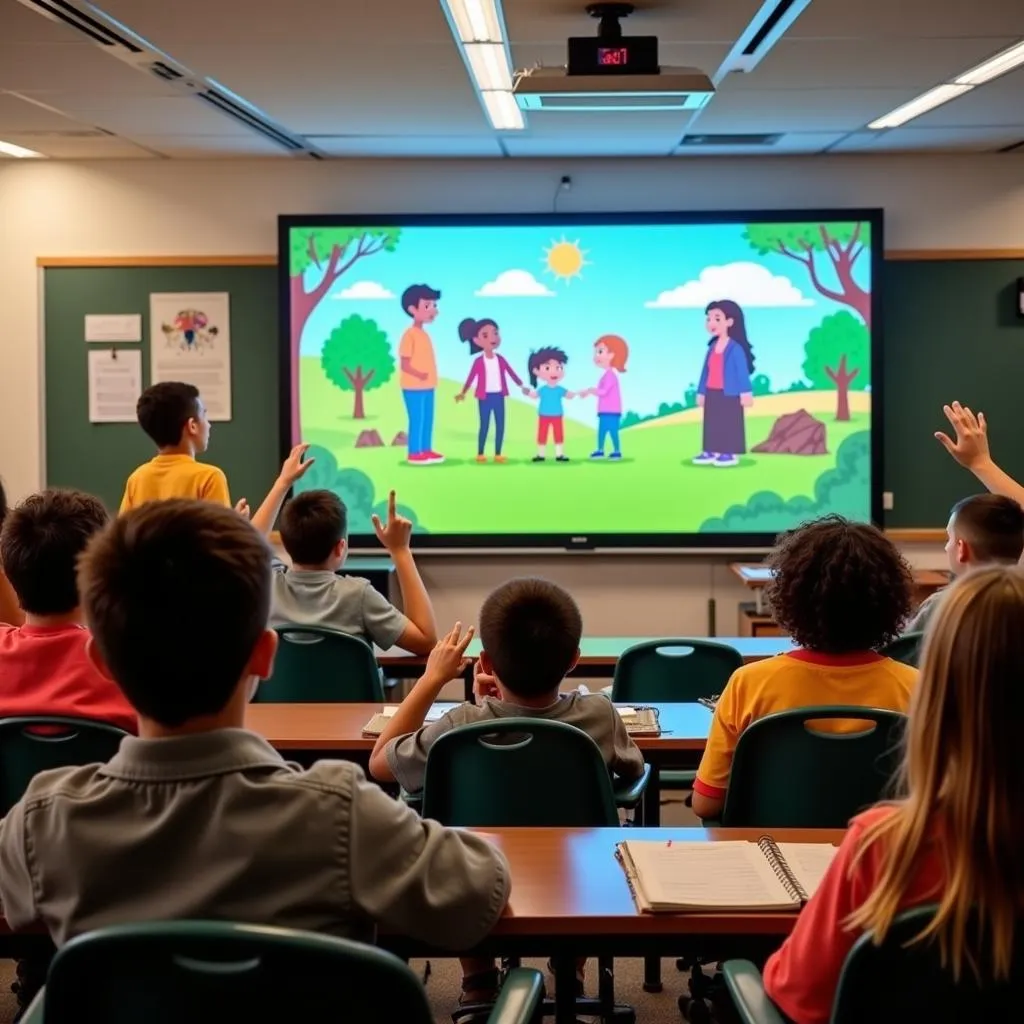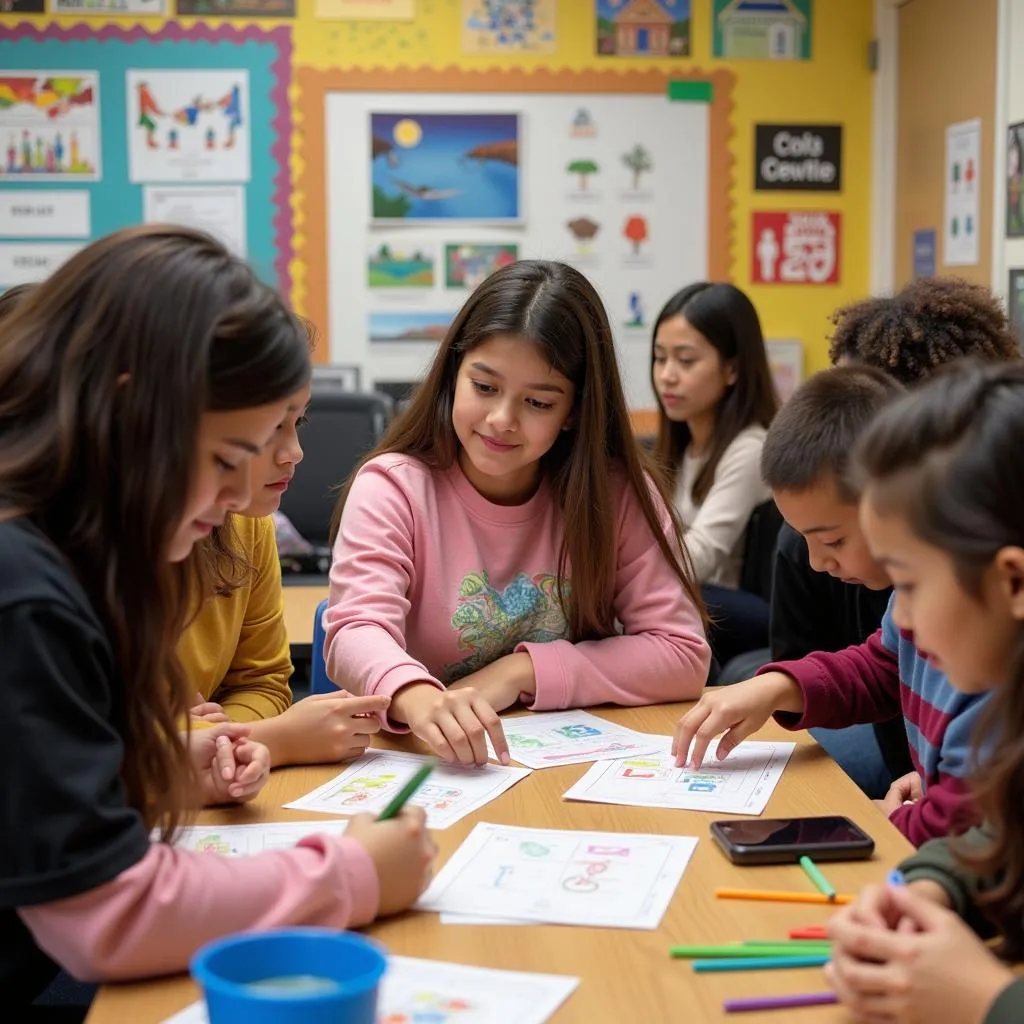Global migration is a phenomenon that significantly impacts educational systems worldwide. As populations become increasingly mobile, countries must adapt their educational policies to accommodate diverse student populations. This IELTS Reading practice test will explore this crucial topic, challenging your comprehension skills while providing insights into the complex relationship between migration and education.
Table Of Contents
- Passage 1 – Easy Text
- The Changing Face of Global Education
- Questions 1-5
- Questions 6-10
- Passage 2 – Medium Text
- Global Migration and Its Impact on Educational Policy
- Questions 11-14
- Questions 15-19
- Question 20
- Passage 3 – Hard Text
- The Paradigm Shift: Global Migration’s Transformative Impact on Educational Policy
- Questions 21-26
- Questions 27-32
- Questions 33-35
- Answer Key
- Passage 1
- Passage 2
- Passage 3
Let’s dive into our IELTS Reading practice test, which consists of three passages of increasing difficulty, each followed by a set of questions. This exercise will not only test your reading comprehension but also enhance your understanding of how global migration shapes educational policies.
Passage 1 – Easy Text
The Changing Face of Global Education
In recent decades, the world has witnessed unprecedented levels of global migration, profoundly impacting various aspects of society, including education. As people move across borders in search of better opportunities or to escape conflict, educational systems worldwide are adapting to accommodate increasingly diverse student populations.
One of the most significant challenges faced by educators is addressing language barriers. Many countries now offer intensive language support programs to help migrant students quickly acquire the language skills necessary for academic success. For instance, in the United States, English as a Second Language (ESL) programs have become a standard feature in schools with high immigrant populations. Similarly, European countries like Germany and Sweden have implemented comprehensive language immersion programs to support newly arrived refugee children.
The role of language barriers in educational access is a critical factor in shaping educational policies for migrant students. Policymakers and educators must consider not only language acquisition but also cultural integration and academic support to ensure equal opportunities for all students.
Another significant trend is the development of multicultural curricula. Recognizing the diverse backgrounds of their student body, many schools are incorporating global perspectives into their teaching materials. This approach not only helps migrant students feel more included but also prepares all students for an increasingly interconnected world.
Furthermore, teacher training programs are evolving to equip educators with the skills needed to manage diverse classrooms effectively. This includes cultural sensitivity training, strategies for differentiated instruction, and techniques for fostering inclusive learning environments.
Questions 1-5
Do the following statements agree with the information given in the passage? Write
TRUE if the statement agrees with the information
FALSE if the statement contradicts the information
NOT GIVEN if there is no information on this
- Global migration has had no impact on educational systems worldwide.
- Language support programs are becoming more common in countries with high immigrant populations.
- All European countries have implemented the same language immersion programs for refugee children.
- Multicultural curricula benefit both migrant and non-migrant students.
- Teacher training programs now include courses on managing culturally diverse classrooms.
Questions 6-10
Complete the sentences below. Choose NO MORE THAN TWO WORDS from the passage for each answer.
- ESL programs are now a __ feature in many U.S. schools with high immigrant populations.
- __ and educators must consider various factors to ensure equal opportunities for migrant students.
- Many schools are incorporating __ into their teaching materials to reflect student diversity.
- Teacher training now includes __ training to help educators manage diverse classrooms.
- Educators are being trained in techniques for fostering __ learning environments.
Passage 2 – Medium Text
Global Migration and Its Impact on Educational Policy
The surge in global migration over the past few decades has precipitated significant changes in educational policies worldwide. As nations grapple with the influx of diverse student populations, they are compelled to reassess and reformulate their approaches to education. This shift is not merely a matter of accommodating linguistic differences; it encompasses a broader spectrum of challenges and opportunities that are reshaping the educational landscape.
One of the most prominent impacts of global migration on educational policy is the emphasis on inclusive education. Countries are increasingly recognizing the need to create learning environments that cater to students from various cultural, linguistic, and socioeconomic backgrounds. This approach goes beyond mere integration; it seeks to celebrate diversity and harness it as a valuable resource for enriching the educational experience of all students.
How multiculturalism shapes modern education systems is evident in the evolving curricula across many countries. There is a growing trend towards incorporating global perspectives, multicultural literature, and diverse historical narratives into course materials. This not only helps migrant students connect with their heritage but also broadens the worldview of native students, preparing them for a globalized future.
Another significant policy shift concerns the assessment and placement of migrant students. Traditional standardized testing methods often fail to accurately measure the abilities of students who are not fluent in the language of instruction. As a result, many countries are developing more nuanced assessment tools that consider a student’s overall cognitive abilities, prior learning experiences, and potential for growth, rather than relying solely on language-based assessments.
Furthermore, the integration of technology in education has taken on new importance in the context of global migration. Digital platforms and online resources are being leveraged to provide supplementary support to migrant students, offering language learning tools, culturally relevant content, and opportunities for personalized learning. This technological integration also facilitates communication between schools and migrant families, bridging potential cultural and linguistic gaps.
The impact of global migration on educational policies extends beyond the classroom. Many countries are implementing community-based initiatives to support the holistic development of migrant students. These programs often involve partnerships between schools, local organizations, and migrant communities to provide mentorship, after-school support, and cultural exchange opportunities.
 Inclusive education in a diverse classroom
Inclusive education in a diverse classroom
However, these policy changes are not without challenges. Funding constraints, political resistance, and the need for rapid adaptation in the face of changing migration patterns pose significant hurdles. Moreover, there is an ongoing debate about how to balance the preservation of national educational standards with the need for flexibility in accommodating diverse student populations.
Despite these challenges, the overall trend in educational policy is moving towards greater inclusivity and adaptability. As global migration continues to shape the demographic landscape of countries worldwide, educational systems are likely to become increasingly dynamic and responsive to the needs of a diverse, global student body.
Questions 11-14
Choose the correct letter, A, B, C, or D.
-
According to the passage, the impact of global migration on education:
A) Is limited to linguistic challenges
B) Affects only developing countries
C) Encompasses a wide range of issues
D) Has been largely negative -
Inclusive education in the context of global migration aims to:
A) Segregate migrant students from native students
B) Focus solely on language acquisition
C) Celebrate diversity and use it as a resource
D) Standardize educational experiences for all students -
The passage suggests that traditional standardized testing methods:
A) Are highly effective for assessing migrant students
B) May not accurately measure migrant students’ abilities
C) Should be the only method used for student assessment
D) Are being completely abandoned in all countries -
According to the text, the use of technology in education for migrant students:
A) Is not important
B) Is limited to language learning
C) Helps only with academic subjects
D) Facilitates various aspects of learning and communication
Questions 15-19
Complete the summary below. Choose NO MORE THAN TWO WORDS from the passage for each answer.
Global migration has led to significant changes in educational policies worldwide. Countries are focusing on (15) __ education to cater to diverse student populations. Curricula are evolving to include (16) __ perspectives and multicultural content. New assessment methods are being developed to consider students’ overall abilities rather than just their (17) __ skills. (18) __ and online resources are being used to support migrant students and communicate with their families. Additionally, (19) __ initiatives are being implemented to support the holistic development of migrant students.
Question 20
Choose the correct letter, A, B, C or D.
- The main challenge in implementing new educational policies for migrant students is:
A) Lack of interest from native students
B) Resistance from migrant communities
C) Funding constraints and political resistance
D) Shortage of qualified teachers
Passage 3 – Hard Text
The Paradigm Shift: Global Migration’s Transformative Impact on Educational Policy
The unprecedented scale of global migration in the 21st century has catalyzed a profound transformation in educational policies worldwide. This shift is not merely a response to demographic changes; it represents a fundamental re-evaluation of the purpose and structure of education in an increasingly interconnected world. As nations grapple with the complexities of integrating diverse student populations, they are compelled to reimagine their educational systems, leading to innovative approaches that challenge traditional paradigms.
One of the most significant developments in this arena is the emergence of transnational education policies. These policies acknowledge that in an era of heightened mobility, education can no longer be confined within national borders. Countries are increasingly collaborating to develop compatible curricula, mutual recognition of qualifications, and streamlined processes for academic transitions across borders. This approach not only facilitates the integration of migrant students but also prepares all learners for a globalized future where cross-cultural competence is paramount.
The concept of cultural capital has gained renewed relevance in shaping educational policies for diverse student bodies. Educators and policymakers are recognizing that migrant students bring valuable cultural and linguistic resources that can enrich the learning environment for all. This recognition has led to the development of asset-based pedagogical approaches that view diversity as a strength rather than a deficit. Such approaches seek to leverage the unique perspectives and experiences of migrant students to foster critical thinking, global awareness, and intercultural understanding among the entire student population.
How language education shapes cultural identity is a critical consideration in these evolving policies. While there is a clear need for migrant students to acquire proficiency in the language of instruction, there is also a growing emphasis on multilingualism and mother tongue preservation. Many countries are implementing dual-language programs and supporting heritage language education, recognizing that linguistic diversity is not only a cultural asset but also a cognitive advantage in an increasingly multilingual global economy.
The digital revolution has played a pivotal role in reshaping educational policies in response to global migration. E-learning platforms, adaptive technologies, and artificial intelligence are being harnessed to provide personalized learning experiences that can adapt to the diverse needs and backgrounds of migrant students. These technologies offer the potential for real-time language support, culturally responsive content delivery, and data-driven insights to inform policy decisions. Moreover, digital tools are enabling unprecedented levels of connectivity between educational institutions worldwide, facilitating knowledge exchange and collaborative learning across borders.
 Global collaboration in education policy
Global collaboration in education policy
The impact of global migration on educational policies extends beyond the K-12 system, influencing higher education and adult learning as well. Universities are internationalizing their curricula, expanding study abroad programs, and developing transnational campuses to cater to an increasingly mobile student population. Additionally, there is a growing focus on lifelong learning and skills development to support the economic integration of adult migrants.
However, the implementation of these progressive policies faces significant challenges. Socioeconomic disparities, political tensions, and ideological resistance to multiculturalism can impede the adoption of inclusive educational practices. Moreover, the rapid pace of demographic changes often outstrips the ability of educational systems to adapt, leading to gaps in provision and inequalities in educational outcomes.
The role of education in global economic development is increasingly recognized as a key factor in shaping migration-responsive educational policies. Countries are striving to align their educational offerings with global labor market demands, recognizing that a well-educated, culturally competent workforce is essential for economic competitiveness in the 21st century.
The evolving landscape of educational policy in response to global migration reflects a broader shift towards a more interconnected, fluid conception of citizenship and identity. As education systems adapt to the realities of mass mobility and cultural diversity, they are not only addressing the immediate needs of migrant students but also reimagining the very foundations of learning in a globalized world. This paradigm shift holds the potential to create more inclusive, adaptable, and globally relevant educational experiences for all learners, regardless of their background or country of origin.
Questions 21-26
Complete the summary using the list of words, A-L, below.
Global migration has led to a (21) __ in educational policies worldwide. Countries are developing (22) __ education policies to address the needs of an increasingly mobile student population. The concept of (23) __ has become important in shaping these policies, recognizing the value that migrant students bring to the learning environment. There is also a growing emphasis on (24) __ and preserving mother tongues in education. The (25) __ has played a crucial role in providing personalized learning experiences for diverse student populations. However, implementing these policies faces challenges such as (26) __ and ideological resistance.
A. socioeconomic disparities
B. digital revolution
C. paradigm shift
D. transnational
E. standardized testing
F. cultural capital
G. monolingualism
H. traditional education
I. multilingualism
J. economic growth
K. political tensions
L. national borders
Questions 27-32
Do the following statements agree with the information given in the passage? Write
YES if the statement agrees with the claims of the writer
NO if the statement contradicts the claims of the writer
NOT GIVEN if it is impossible to say what the writer thinks about this
- Transnational education policies are designed to keep education confined within national borders.
- Asset-based pedagogical approaches view student diversity as a strength.
- E-learning platforms and AI are being used to provide personalized learning experiences for migrant students.
- The impact of global migration on educational policies is limited to the K-12 system.
- All countries have successfully implemented inclusive educational practices without any challenges.
- Education systems adapting to global migration are reimagining the foundations of learning in a globalized world.
Questions 33-35
Choose the correct letter, A, B, C or D.
-
According to the passage, cultural capital in education refers to:
A) Financial resources of migrant families
B) Cultural and linguistic resources that migrant students bring
C) Physical assets of educational institutions
D) Government funding for multicultural programs -
The digital revolution in education has enabled:
A) Elimination of all language barriers
B) Replacement of traditional classroom teaching
C) Personalized learning and cross-border collaboration
D) Standardization of global curricula -
The passage suggests that the future of education in response to global migration will likely be:
A) More nationalistic and isolationist
B) Focused solely on economic outcomes
C) Unchanged from current systems
D) More inclusive, adaptable, and globally relevant
Answer Key
Passage 1
- FALSE
- TRUE
- NOT GIVEN
- TRUE
- TRUE
- standard
- Policymakers
- global perspectives
- cultural sensitivity
- inclusive
Passage 2
- C
- C
- B
- D
- inclusive
- global
- language
- Digital platforms
- community-based
- C
Passage 3
- C
- D
- F
- I
- B
- A
- NO
- YES
- YES
- NO
- NO
- YES
- B
- C
- D
This comprehensive IELTS Reading practice test on “How global migration shapes educational policies” provides valuable insights into the complex relationship between international mobility and education systems worldwide. By engaging with these texts and questions, you’ve not only honed your reading comprehension skills but also gained a deeper understanding of the challenges and innovations in global education.
How global education rankings affect cultural perceptions is another fascinating aspect of this topic that you might want to explore further to broaden your understanding of global educational dynamics.
Remember, success in the IELTS Reading test comes from regular practice and developing effective strategies for different question types. Keep practicing with diverse topics and question formats to improve your skills and confidence for the actual exam.


